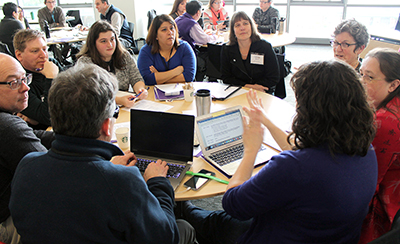Discussion Summaries

The following are examples of responses given to discussion questions.
What challenges have you encountered in implementing Policy #188? What strategies, if any, have you found to overcome them?
Challenges are wide and far in implementing Policy #188 across postsecondary institutions. A list of discussed challenges is listed below, with a section of specific challenges and mentioned solutions listed under that.
- How do we manage people’s time in getting these tasks done?
- Which videos should be captioned first?
- How do we change campus culture and get buy-in from others, insteading faculty and staff?
- Where do we find the funding?
- How do we make accessibility less overwhelming for others?
- How will we test hardware and software for accessibility?
- How do we get buy-in from all departments?
- How do we make sure open source software is accessible?
- How do we manage leadership turnover and continual changes in strategic plans?
- How do we promote better training resources?
- How do we keep up with changing technology?
- How do we keep things moving fast at a slow-moving institution?
Listed below are challenges and solutions presented by participants:
- Challenge: How do we respond to faculty pushback and non-followthrough?
Solution: Faculty contract negotiated, 10-hour mandatory training for all faculty, won’t be eligible for rehire if they don’t take training. - Challenge: How do we make accessibility a priority within procurement?
Solution: Create a checklist and make a process to ensure software must be accessible or working towards accessibility before purchased. - Challenge: How do we get higher ups and central administration to have a strong message on accessibility?
Solution: Promote and recognize higher administration as models of accessibility and promote how they can use it within their society. Labeling administration as allys can then make them an ally. - Challenge: How do we get more buy-in from stakeholders?
Solution: Show both a big picture and show how changes can make results and a difference. - Challenge: How do we get the information out for where people can find accessibility experts on campus?
Solution: Better communicate across campus how to contact those in charge of accessibility. - Challenge: Where do we find the funding the pay for the training, time, implementation, new software, etc?
Solution: Find money by charging proportional costs to departments or raise the tech fee. - Challenge: How do we test hardware and software for accessibility?
Solution: We created CATO to help manage and test software across campus, and we have promoted someone to be in charge of managing IT accessibility. - Challenge: How do we get buy-in from others across campus departments?
Solution: Spend time building a small team that can then promote accessibility and pull more and more people in. Value trust in relationships and grow until you cover all of campus. - Challenge: How do we get people to make and use accessible PDFs?
Solution: We promote people not using PDF if it is possible, and instead use protected Word documents. If they do have to use PDFs, follow a centralized trusted guide for creating accessible PDFs.
How can campuses work together to implement Policy #188?
- If we can all mention what we do and work across different institutions to complete tasks, as well as share resources. If one campus doesn’t have a policy or message, other campuses that do have those items should share their wording or ideas.
- How can we improve communication among both community colleges and larger universities? We can create more listservs and include more people in communities. Creating a common website or knowledge base would be very helpful to share knowledge that all schools should be using. Piggy back on other meetings to include accessibility in wider circles.
- Adding more people to the larger communities of practice to make sure more people are included in accessibility efforts.
- Having more accessibility experts and coordinators that can work with others across campuses and on individual campuses.
- Join EDUCAUSE, ATHEN, WAPED, and other communities that can share accessibility resources and knowledge.
- Informal collaboration needs to become more formal to allow everyone access to all information and in the loop as possible.
- Host more events to bring us together and collaborate more often.
- Can we get WATEch to do more for Policy #188?
- Developing language for procurement that can be utilized across the state.
- Hire students with disabilities to work across campuses to make sure materials and classes are being made accessible.
- Make sure faculty are included in campus and statewide endeavors for accessibility.
- Have separate four-year institution and two-year institution meetings for accessibility and then meet to share ideas and differences.
- A lot of recent coversations have come up about testing and sharing evaluation tools--can we join these conversations with accessibility?